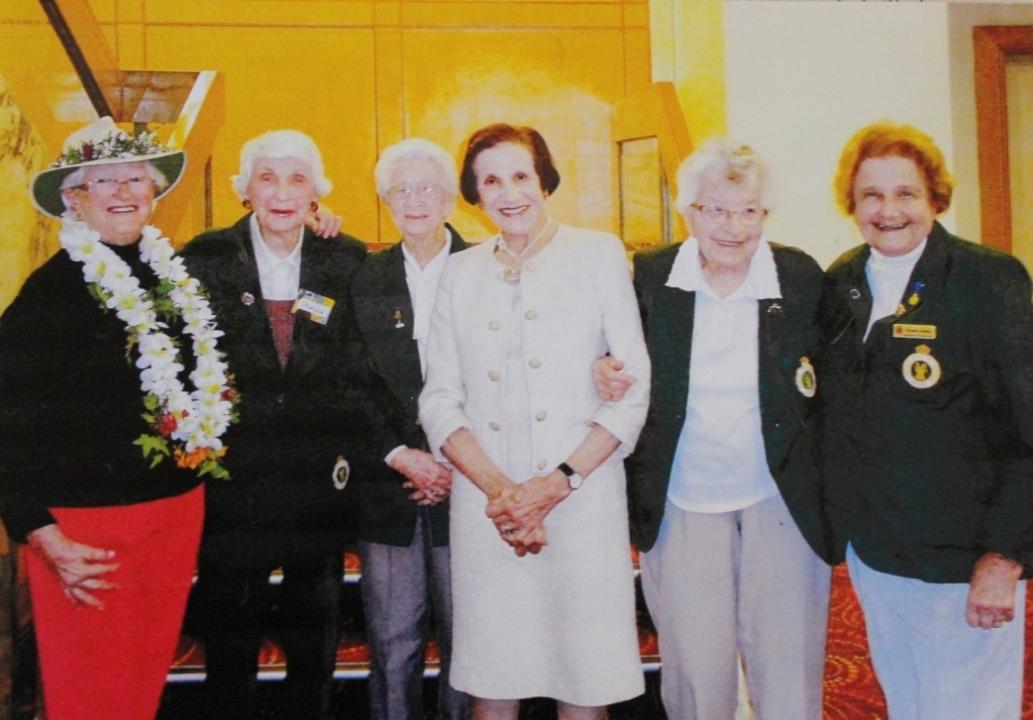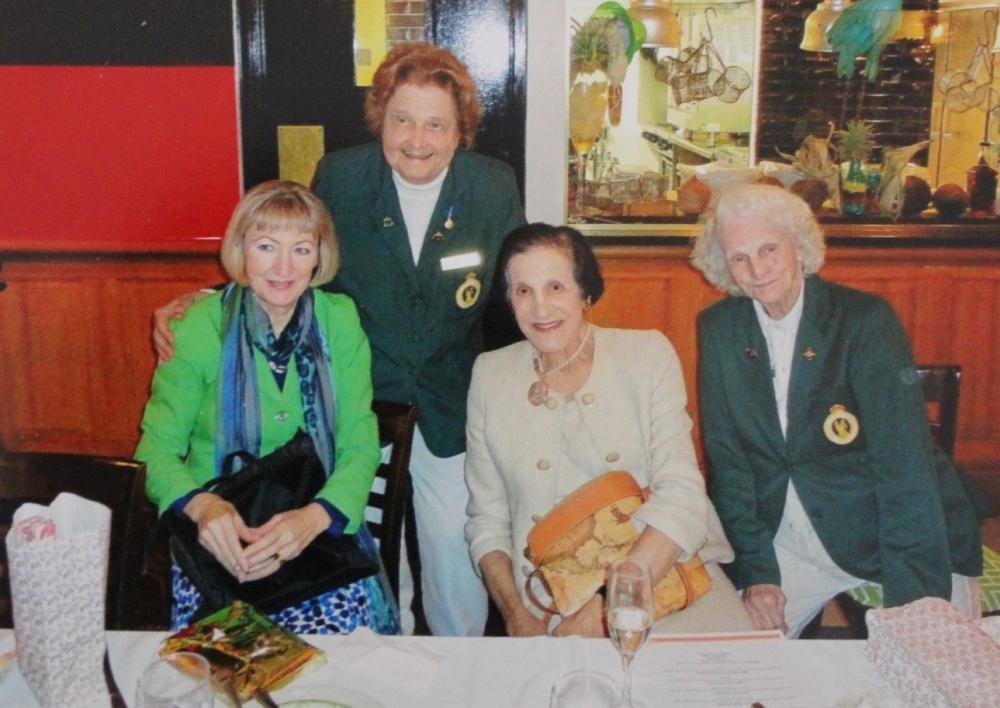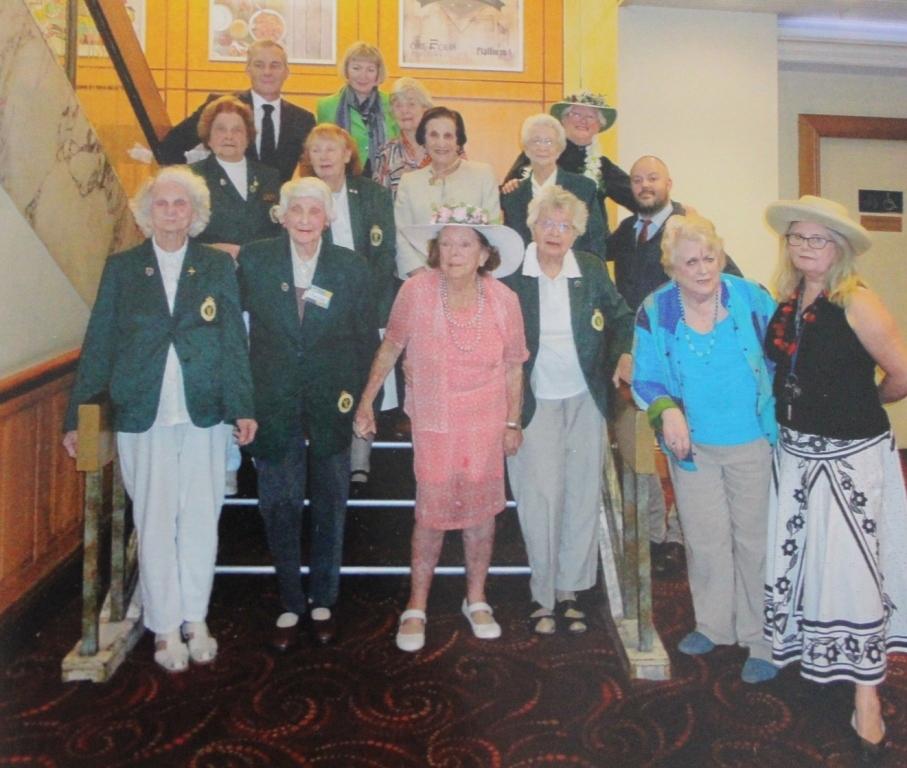Land Army Spring Luncheon 2016

Land Army Spring Luncheon 2016
by Doreen Cherry OAM
We have been blessed!
We have been treated to a reunion with someone we love and admire!
Professor The Honourable Dame Marie Bashir AD CVO graciously accepted an invitation to join us at the Menzies Hotel Sydney for our Spring Luncheon last Wednesday 28th September.
Dame Marie is a true friend and supporter of the Australian Women's Land Army.
Dame Marie Bashir was just a teenager and visiting a farm in Junee NSW with her mother when she first met Land Army girls. She has never forgotten our efforts to save the farms for the boys coming home from the war and feeding our nation and American Service Men and Women in the South Pacific. Nor has she ever forgotten to tell us of her admiration for our efforts.
No wonder our late Governor so admired you all after seeing how tough your life was to help the war effort.
My gratitude was visible as this was the very last of such get togethers I will be organizing as The Menzies Hotel has been sold and will become offices in the future and be closed before Christmas 2016.
You all looked so smart and well-groomed wearing your blazers and you glowed with happiness. Thank you for all your support and friendship as always you made me made feel me very proud.

Left to right: Rose Petersen (author of The Diamond Jubilee State Coach), Doreen Cherry OAM, Professor The Honourable Dame Marie Bashir AD CVO and Gladys Alder, Narrabeen lady
The Land Army Women's Reunion Group will resume their attendances in Hyde Park Sydney next year for the 2017 Aboriginal and Torres Strait Islander Veterans Commemorative Service. Organised by Sydney RSL, this Commemoration Service will be held at the Anzac Memorial Hyde Park South. It is held each year on the last Friday in May at 11am for wreath laying and educating the many schools who attend on the service given by our indigenous peoples in all conflicts in which Australians have served.
Thank you for your further donations of scarves for "Look Good Feel Better for Cancer".
Thank you for the lovely blue orchids and kind words.
Thank you to all the staff at the Menzies especially Andrew Austin, Sarah and Chef for the fine dining, damask and lace table setting, floral art and choice of menu of tasty meals and the unexpected gift of delicious dessert presentations including white fairy floss in ruby red stemmed wine glasses - all very special.
Thank you to Margaret Messer for her back up and attending in memory of her Land Army mother, firstly as our secretary and hands on at our lunches. Surely there’s no keener associate member to be actively motivated even with trips to the Griffith Land Army Museum!
We have also been blessed with generous supporters like Susie Elelman for transport and lunches, President Peggy and Patron Cess Williams for their huge achievements long-term, and our other Patrons, the Hon Bronwyn Bishop, and for me the Avalon Beach R.S.L.
Yes the Australian Women's Land Army veteran members of 1941-1945 are not only stoic, agreeable, and truly caring of each other, they enjoyed their time as Land Army Girls trying to support the War effort and making lasting friendships. Prime Minister Curtin declared them the 4th branch of the women's services. They only had each other for support after tackling ridiculously heavy workloads.
I feel honoured to have been able to support you all having not joined the Land Army until January 1945.
Attendees Women’s Land Army Spring Luncheon at The Menzies: September 2016

Professor The honourable Dame Marie Bashir AD CVO
Lady Yvonne Lennard
Doreen Cherry
Nancy Hammond
Althea Huctheson
Gladys Alder
Happy (Dorothy) Cleverley
Margaret Merser
Rose Petersen – Special Guest
Elizabeth Aird – Supporter
Beverly Davies – Supporter
Josephine – Carer for Lady Leonard
Shiela van Emden
Heath Ramsay, my grandson, shares photos from the celebration for your enjoyment.
Australian Women’s Land Army
The Australian Women’s Land Army (AWLA) was formed during the Second World War to combat rising labour shortages in the farming sector. From December 1941, when Japan entered the war, the nation’s need to build up its armed forces was placed above the needs of other industries. Agricultural labour was steadily diverted to the armed services and war industry.
To meet the shortfall in rural labour, State and private women’s land organisations were organised, modelled on those established in Great Britain during the First and Second World Wars. A national body was formed on 27 July 1942 under the jurisdiction of the Director General of Manpower. While policy was devised by the Commonwealth Government, the organisation of the AWLA remained State-based. An extensive recruiting campaign was undertaken for new members. Most members of the existing land armies were later incorporated into the AWLA as well.
The AWLA was planned to function in two divisions:
• Full-time members: These enrolled for continuous service for 12 months (with the option of renewal); such members were to receive appropriate badges, distinctive dress uniform, working clothes, and equipment.
• Auxiliary members: These were available for periods of not less than four weeks at nominated times of the year; such members were to be used for seasonal rural operations, and to receive a badge, working clothes, and essential equipment on loan.
Recruits had to be between 18 and 50 years of age and be British subjects or immigrants from Allied nations. Women on the land who were farmers, employees or relatives of land holders were not eligible to enlist. AWLA women were generally drawn from city areas and were often unskilled in rural work. This new form of labour had to be heavily promoted to rural employees, who were initially resistant to female labour. Sceptical attitudes, however, generally changed to praise and respect.
Enrolment numbers peaked in December 1943, with 2,382 permanent members and 1,039 auxiliary members. The average working week for an AWLA member was 48 hours, with pay starting at the AWLA minimum wage of 30 shillings a week. Permanent members were also entitled to sick pay. Women were paid much less than their male counterparts for the same work, which covered a variety of agricultural labours, such as vegetable and fruit growing, pig and poultry raising, and sheep and wool work.
In October 1942 the Minister for Labour and National Service, aware of the need to compete with the three women’s services, recommended improving the status of the AWLA by instituting it as a fourth service. In January 1943 Cabinet endorsed the status of both divisions of the AWLA as an "official fourth service". The organisation was to be formally constituted under the National Security Regulations. A final draft of these regulations, however, was not completed until 1945, and was not acted upon before the end of the war and the demobilisation of the AWLA. As a result, members of the AWLA were not accorded the same benefits as members of the other women’s services.
The AWLA was disbanded on 31 December 1945. In 1997, many members became eligible for the Civilian Service Medal, after a Committee of Enquiry recommendation in 1994.
Sources:
"History of Australian Women's Land Army, 27 July 1942 – 31 December 1945" AWM54 1025/4/1 [Original record available only at the Australian War Memorial]
National Archives of Australia Agency Notes for the AWLA (New South Wales Branch)
Peter Dennis et al. "Australian Women’s Land Army", in The Oxford Companion to Australian military history (Melbourne: Oxford University Press, 1995)
Australian War Memorial Education page: https://www.awm.gov.au/encyclopedia/homefront/land_army/